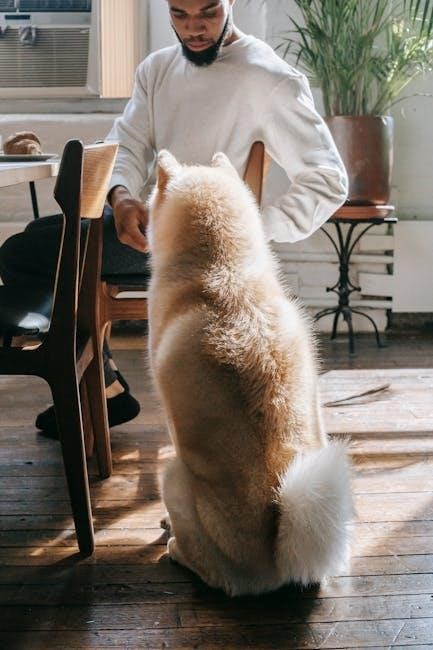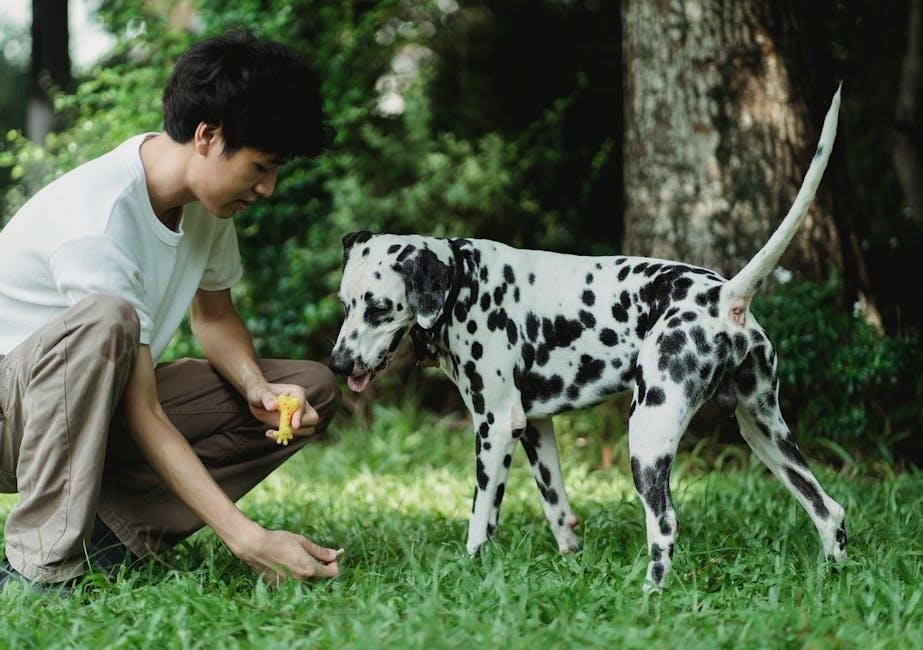Ensuring a safe environment for pets involves understanding plant toxicity. Many common plants, like lilies and sago palms, can be harmful. This guide helps pet owners make informed choices to protect their furry friends, promoting a harmonious and hazard-free home.
Why Plant Safety Matters for Pets
Plant safety is crucial for pet owners to prevent accidental poisoning. Many common plants, such as lilies, sago palms, and oleander, contain toxins that can harm pets. Even small amounts of certain plants can cause severe health issues, including organ damage or death. Pets, especially curious dogs and cats, often ingest plants out of curiosity or boredom, making it essential to identify and avoid toxic species. Being informed about plant toxicity allows pet owners to create a safer living environment and take preventative measures to protect their furry friends. Awareness can truly be a lifesaver for pets.
By understanding which plants are harmful, owners can make informed decisions about landscaping and indoor decor. This knowledge also enables quick action if a pet ingests a toxic plant, potentially saving their life. Always double-check the safety of any plant before bringing it into a pet-friendly space.
Understanding Toxic and Non-Toxic Plants
Toxic and non-toxic plants are categorized based on their potential to cause harm if ingested by pets. Toxic plants contain compounds that can trigger adverse reactions, ranging from mild gastrointestinal upset to life-threatening conditions. These compounds might be present in leaves, stems, flowers, or roots. Non-toxic plants, while safer, may still cause discomfort if eaten in large quantities. It’s essential to research each plant’s safety, as even seemingly harmless species can pose risks. For example, lilies are highly toxic to cats, while spider plants are generally safe. Knowing the difference helps pet owners create a secure environment and make informed decisions about which plants to bring into their homes.
The ASPCA provides a comprehensive list of toxic and non-toxic plants, serving as a valuable resource for pet owners.
Common Toxic Plants to Pets
Many common plants pose serious risks to pets, including lilies, sago palms, and oleander. These can cause severe health issues, making awareness crucial for pet safety.
Lilies: Highly Toxic to Cats and Dogs
Lilies are among the most dangerous plants for pets, especially cats. Even small amounts of lily pollen, leaves, or flowers can cause severe kidney damage. All parts of the lily plant are toxic, and ingestion can lead to life-threatening complications. Symptoms include vomiting, lethargy, and loss of appetite, which can progress rapidly; Prompt veterinary care is essential if a pet ingests any part of a lily. Prevention is key, as there is no safe way to keep lilies in a pet-friendly environment. Removing lilies from homes with cats or dogs is the best way to ensure their safety and avoid potential tragedy.
Sago Palm: One of the Most Dangerous Plants
The Sago Palm, scientifically known as Cycas revoluta, is highly toxic to both pets and humans. Its seeds are particularly dangerous, containing cycasin, a compound that can cause severe liver failure. Even small amounts of ingestion can lead to life-threatening complications. Symptoms in pets include vomiting, diarrhea, lethargy, and abdominal pain, which can rapidly progress to liver dysfunction. Immediate veterinary attention is critical if a pet ingests any part of the Sago Palm. Pet owners should avoid keeping this plant in or around their homes, as the risks far outweigh its aesthetic benefits. Removing it entirely is the safest option to protect furry family members.
Oleander: A Deadly Plant for Pets
Oleander, a beautiful yet highly toxic plant, poses a significant threat to pets. All parts of the oleander plant, including leaves, flowers, and stems, contain toxic compounds called oleandrin and neriine; Even small amounts ingested can cause severe health issues in pets, including vomiting, irregular heartbeats, and death. Pets may exhibit symptoms such as drooling, tremors, and difficulty breathing shortly after ingestion. Due to its high toxicity, oleander has no safe level of exposure for animals. Pet owners should avoid growing oleander in their gardens or bringing it into their homes. If ingestion is suspected, immediate veterinary care is essential to prevent fatal outcomes. This plant is a clear example of why awareness of toxic flora is crucial for pet safety.
Azalea and Rhododendron: Toxic Flowers

Azalea and rhododendron plants are stunning additions to gardens but pose a serious risk to pets. These flowers contain grayanotoxins, which are highly toxic to both dogs and cats. Even small amounts of ingested plant material, such as leaves or flowers, can cause severe symptoms, including vomiting, drooling, and abdominal pain. In more severe cases, pets may experience tremors, seizures, or even heart failure. All parts of the plant are toxic, and the risk is not limited to blooming seasons. Pet owners should avoid growing these plants in pet-accessible areas. If ingestion occurs, immediate veterinary attention is crucial to prevent life-threatening complications. Awareness of these toxic flowers is essential for safeguarding pets and creating a safer outdoor environment.
Tulip and Narcissus Bulbs: Hidden Dangers
Tulip and narcissus bulbs are highly toxic to pets, containing compounds like tulipalin and lycorine. These substances can cause severe gastrointestinal symptoms, such as vomiting and drooling, in dogs and cats. The bulbs are particularly dangerous, as they hold the highest concentration of toxins. Even small amounts ingested can lead to more serious health issues, including respiratory distress and cardiac problems. While the flowers themselves are less toxic, they still pose a risk. Pet owners should keep these plants out of reach or consider safer alternatives. Awareness of these hidden dangers is key to protecting pets from accidental poisoning and ensuring a safe, plant-friendly environment at home.
Cyclamen: Toxic to Dogs and Cats
Cyclamen plants are highly toxic to both dogs and cats, primarily due to the presence of saponins in their tubers. These compounds can cause severe gastrointestinal distress, including vomiting, diarrhea, and excessive drooling, if ingested. In more severe cases, cyclamen toxicity can lead to heart arrhythmias and even liver or kidney failure. The tubers, which are underground storage organs, contain the highest concentration of toxins, making them particularly dangerous. Pet owners should exercise extreme caution and keep cyclamen plants out of reach. Early signs of poisoning, such as lethargy or loss of appetite, warrant immediate veterinary attention. Ensuring these plants are inaccessible is crucial for maintaining pet safety and preventing potential health crises.
Autumn Crocus: A Poisonous Fall Plant
The Autumn Crocus (Colchicum autumnale) is a highly toxic plant, particularly dangerous for pets. It contains colchicine, a compound that can cause severe poisoning in both dogs and cats if ingested. Symptoms of toxicity include vomiting, diarrhea, abdominal pain, and lethargy, which can progress to more serious conditions like respiratory failure or organ damage. The bulbs of the plant are especially hazardous, as they contain the highest concentration of toxins. Pet owners should avoid planting Autumn Crocus in pet-accessible areas and ensure any existing plants are kept out of reach. Immediate veterinary attention is crucial if ingestion is suspected, as prompt treatment can significantly improve outcomes. This plant is a significant risk, making it essential to prioritize pet safety during the fall season.
Bluebells: Toxic Berries and Bulbs
Bluebells (Hyacinthoides species) are charming spring flowers, but they pose a risk to pets. Both their berries and bulbs contain toxic compounds that can harm dogs and cats if ingested. While the toxicity level is generally mild, consuming even small amounts can lead to gastrointestinal upset, including vomiting, diarrhea, and lethargy. The bulbs, in particular, are the most toxic part of the plant. Pet owners should avoid planting bluebells in areas accessible to their pets and ensure any existing plants are out of reach; Monitoring your pet’s behavior around plants is crucial, and if ingestion occurs, consulting a veterinarian promptly is recommended to address any potential health issues. This precaution helps ensure a safer environment for furry family members.
Indoor Plants and Their Toxicity
While indoor plants enhance air quality, many are toxic to pets. Ferns, lilies, and snake plants can cause harm if ingested, making awareness crucial for pet safety.
Ferns: A Common Houseplant with Risks
Ferns are popular houseplants known for their lush, green foliage, but they pose risks to pets. These plants are toxic to both cats and dogs, with symptoms including nausea and vomiting. The entire plant is harmful if ingested, and even small amounts can cause discomfort. While ferns are appealing for indoor spaces, pet owners must exercise caution. If you suspect your pet has eaten a fern, seek veterinary care immediately. To ensure safety, consider replacing ferns with pet-friendly alternatives like spider plants or parlor palms. Awareness of these risks is key to maintaining a safe and welcoming environment for both plants and pets to coexist harmoniously.
Outdoor Plants to Beware Of
Common outdoor plants like Allium species, tomato and potato plants, rhubarb leaves, and castor beans pose serious health risks to pets. Keep these toxic plants out of reach to ensure your pet’s safety and well-being.
Allium Species: Onions, Garlic, and Chives
Allium species, including onions, garlic, and chives, are highly toxic to pets. These plants contain compounds that can cause severe health issues, even in small amounts. Whether raw, cooked, or powdered, they are dangerous to both dogs and cats. Ingestion can lead to symptoms like vomiting, lethargy, and difficulty breathing. Prolonged exposure or larger quantities can damage a pet’s red blood cells, potentially leading to anemia. These plants are harmful at every stage, making them a significant risk in gardens and kitchens. Pet owners should avoid growing Allium species in pet-accessible areas and ensure food waste containing these ingredients is securely disposed of to prevent accidental ingestion.
Tomato and Potato Plants: Green Parts Are Toxic
Tomato and potato plants, while nutritious when ripe, pose risks to pets due to their green parts. These sections, including leaves and stems, contain solanine, a toxic compound that can harm both dogs and cats. Ingestion may lead to symptoms like vomiting, diarrhea, and abdominal pain. Even unripe fruits of these plants have higher solanine levels, increasing toxicity. However, fully ripe tomatoes and potatoes are generally safe for pets in moderation. Pet owners should dispose of green plant parts securely and keep unripe fruits out of reach to prevent accidental poisoning, ensuring a safe environment for their pets to thrive.
Rhubarb Leaves: A Garden Danger
Rhubarb leaves are highly toxic to pets due to their high oxalic acid content. Ingestion can lead to severe health issues, including vomiting, diarrhea, and abdominal pain. Prolonged exposure may cause kidney damage in dogs and cats. Pet owners should ensure rhubarb leaves are kept far out of reach, as even small amounts can be harmful. While the stalks are safe for human consumption, the leaves pose a significant risk. Regularly monitoring your garden and disposing of fallen leaves can help prevent accidental poisoning. This simple precaution ensures a safer outdoor environment for curious pets to explore and play.
Castor Bean: A Plant with Severe Consequences
The castor bean plant, known for its distinctive seeds and foliage, contains ricin, a highly toxic compound. Even small amounts ingested by pets can lead to severe poisoning. Symptoms in dogs and cats include vomiting, diarrhea, and abdominal pain, which can progress to organ failure if untreated. Pet owners should avoid growing castor beans in gardens and ensure pets cannot access any parts of the plant. Regular monitoring of outdoor spaces and keeping toxic plants out of reach are essential preventive measures. Immediate veterinary care is crucial if poisoning is suspected, as early treatment can significantly improve outcomes for affected pets.

Non-Toxic Alternatives for Pet-Friendly Spaces
Pet-friendly spaces can feature non-toxic plants like spider plants, parlor palms, and zinnias. These options ensure safety while adding beauty and freshness to indoor environments.
Spider Plants: A Safe Choice for Homes
Spider plants are an excellent choice for pet-friendly homes due to their non-toxic nature. They are easy to care for, thrive in various lighting conditions, and add a touch of greenery to any room. Known for their air-purifying qualities, spider plants help maintain a healthy indoor environment. Their cascading leaves and baby plantlets make them visually appealing and easy to propagate. Pet owners can enjoy their beauty without worrying about harming their furry friends, making them a perfect addition to a safe and welcoming space.
Parlor Palm: A Pet-Friendly Indoor Plant
Parlor palms are a popular, pet-friendly choice for indoor spaces. Known for their elegant, feathery leaves, these palms are non-toxic to both cats and dogs, making them a safe addition to any home. They thrive in low-light conditions and require minimal maintenance, making them ideal for busy pet owners. Parlor palms also act as natural air purifiers, improving indoor air quality without posing a risk to furry friends. Their slender growth habit allows them to fit seamlessly into various interior designs. With proper care, they can grow tall and graceful, adding a touch of tropical beauty to pet-safe environments. This plant is a great option for creating a welcoming and hazard-free space for pets and people alike.
Zinnias: Colorful and Safe Flowers
Zinnias are a vibrant and pet-friendly flower option, perfect for adding color to gardens or indoor spaces; Unlike many flowering plants, zinnias are non-toxic to cats, dogs, and other pets, making them a great choice for pet owners. These flowers come in a wide variety of colors and sizes, offering flexibility for diverse decorative needs. They are relatively easy to grow, thrive in well-drained soil, and require minimal maintenance. Zinnias are ideal for creating a cheerful, pet-safe environment where your furry friends can explore without risk. Their safety and beauty make them a popular pick for gardens and homes alike, ensuring a harmonious space for both pets and plants to coexist happily.

Recognizing Symptoms of Plant Poisoning
Symptoms of plant poisoning in pets include vomiting, drooling, lethargy, and loss of appetite. Severe cases may involve seizures or difficulty breathing, requiring immediate veterinary attention.
Common Signs of Plant Toxicity in Pets
Pets exposed to toxic plants often display symptoms like vomiting, drooling, lethargy, and loss of appetite. In severe cases, they may experience seizures, tremors, or difficulty breathing. These signs can appear rapidly after ingestion, varying in intensity based on the plant and amount consumed. Gastrointestinal distress, such as diarrhea or excessive salivation, is also common. Recognizing these indicators early is crucial for timely intervention. If you suspect plant poisoning, monitor your pet closely and seek veterinary care immediately to prevent potentially life-threatening complications.
Emergency First Aid for Plant Poisoning
If you suspect your pet has ingested a toxic plant, act quickly. Contact your veterinarian or a pet poison hotline immediately for guidance. Do not induce vomiting unless instructed by a professional. Remove any remaining plant material from your pet’s mouth or fur to prevent further exposure. Keep your pet calm and monitor their condition closely for signs of distress. Administering any medications without veterinary advice is risky and could worsen the situation. Time is critical, as prompt treatment can significantly improve outcomes. Always have emergency contact information readily available to ensure the best chance of recovery for your pet.

Preventive Measures for Pet Owners
Identify toxic plants, keep them out of reach, and opt for pet-safe alternatives. Regularly inspect your space and secure any potentially harmful plants to ensure your pet’s safety.
How to Pet-Proof Your Garden
To create a pet-safe garden, start by removing or securing toxic plants like lilies, sago palms, and autumn crocus. Replace them with non-toxic alternatives such as zinnias or spider plants. Use physical barriers, like fences or elevated planters, to restrict access to harmful areas. Regularly inspect your garden for new growth or invasive species that might pose a risk. Supervise your pets during outdoor activities and train them to avoid certain zones. Consider creating a designated “pet zone” with safe, durable plants where your furry friends can play freely. These steps ensure a secure and enjoyable outdoor space for both you and your pets.
Keeping Toxic Plants Out of Reach
Keeping toxic plants out of your pet’s reach is essential for their safety. Start by relocating toxic plants to high shelves or hanging baskets where pets cannot access them; Use physical barriers, such as baby gates or plant covers, to restrict access to dangerous areas of your garden. Label toxic plants clearly so you and others are aware of their risks. Supervise your pets when they are in the garden or near indoor plants to prevent accidental ingestion. Consider replacing toxic plants with pet-friendly alternatives to create a safer environment. By taking these steps, you can minimize the risk of plant poisoning and protect your furry companions from harm.
Creating a safe environment for pets requires awareness of toxic plants. By choosing pet-friendly options and keeping harmful plants out of reach, you ensure their well-being and happiness.
Creating a Safe Environment for Pets
Creating a safe environment for pets involves careful planning and awareness of potential hazards. Start by researching plants before bringing them into your home or garden. Opt for non-toxic alternatives like spider plants or parlor palms, which are safe for curious pets. Outdoor spaces should be pet-proofed, with secure fencing and toxic plants kept out of reach. Regularly inspect your garden for harmful species like lilies or sago palms. Additionally, educate yourself on the symptoms of plant poisoning and keep emergency contact information handy. By taking these steps, you can ensure a peaceful and secure space where your pets can thrive without risking their health.



